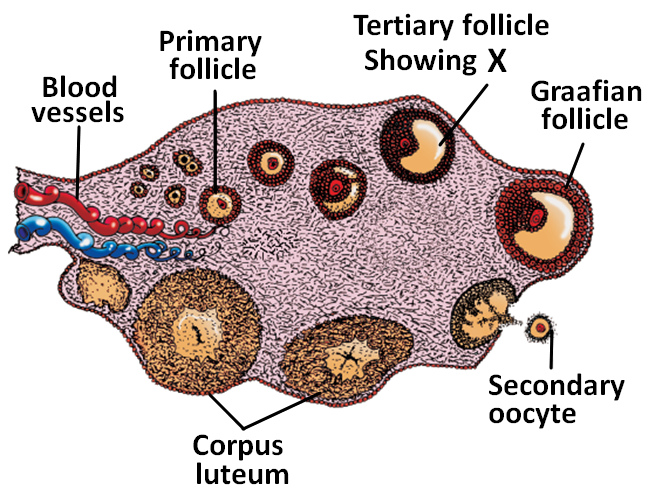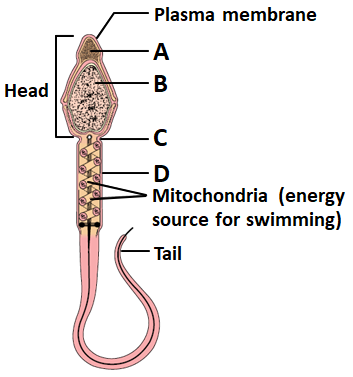Select Question Set:
Where and when does fertilization typically occur?
1. Uterus; Within 7 days after ovulation
2. Ovary; Immediately before ovulation
3. Fallopian tube; Within 24 hours of ovulation
4. Vagina; Within 24 hours of insemination
Subtopic: Fertilization |
92%
Level 1: 80%+
Please attempt this question first.
Hints
The onset of puberty:
| I: | in males is due to secretion of GnRH by the hypothalamus. |
| II: | in females is due to secretion of GnIH by the hypothalamus. |
1. Only I is correct
2. Only II is correct
3. Both I and II are correct
4. Both I and II are incorrect
Subtopic: Seminiferous Tubules & Spermatogenesis |
76%
Level 2: 60%+
Please attempt this question first.
Hints
Please attempt this question first.
What is the fate of the corpus luteum if fertilization fails to happen during a menstrual cycle?
| 1. | It is expelled into the pelvic cavity. |
| 2. | It increases the secretion of FSH. |
| 3. | It degenerates into the corpus albicans. |
| 4. | It maintains endometrium until the next ovulation. |
Subtopic: Menstrual Cycle: Luteal Phase |
89%
Level 1: 80%+
Please attempt this question first.
Hints
Spermiation is the process of the release of sperms into:
| 1. | Seminiferous tubules | 2. | Vas deferens |
| 3. | Epididymis | 4. | Prostate gland |
Subtopic: Seminiferous Tubules & Spermatogenesis | Spermiogenesis/Sperm Structure/Hormonal Regulation |
80%
Level 1: 80%+
Please attempt this question first.
Hints
Please attempt this question first.
Consider the given two statements:
| Assertion (A): | The secondary oocyte retains bulk of the nutrient rich cytoplasm of the primary oocyte. |
| Reason (R): | The division of primary oocyte is an unequal division resulting in the formation of a large haploid secondary oocyte and a tiny first polar body. |
| 1. | Both (A) and (R) are True and (R) is the correct explanation of (A). |
| 2. | Both (A) and (R) are True but (R) is not the correct explanation of (A). |
| 3. | (A) is True but (R) is False. |
| 4. | (A) is False but (R) is True. |
Subtopic: Female Reproductive System-1 | Female Reproductive System-2 | oogenesis |
65%
Level 2: 60%+
Please attempt this question first.
Hints
Please attempt this question first.
What is ‘X’ called in the given figure?


| 1. | ampulla | 2. | antrum |
| 3. | blastocoel | 4. | enterocoel |
Subtopic: Female Reproductive System-1 | Female Reproductive System-2 |
92%
Level 1: 80%+
Please attempt this question first.
Hints
Please attempt this question first.
At puberty, the number of follicles remaining in each ovary is between:
| 1. | 30000-40000 | 2. | 60,000-80,000 |
| 3. | 120000-160000 | 4. | 240000-320000 |
Subtopic: Female Reproductive System-1 | Female Reproductive System-2 |
92%
Level 1: 80%+
Please attempt this question first.
Hints
Please attempt this question first.
Which alphabet in the given figure represents the structure that carries two pairs of centrioles?

1. A
2. B
3. C
4. D

1. A
2. B
3. C
4. D
Subtopic: Male Reproductive Duct System | Semen and Male Fertility |
59%
Level 3: 35%-60%
Please attempt this question first.
Hints
Please attempt this question first.
Human chorionic gonadotropin is secreted by trophoblast cells as well and this hormone resembles in action to:
| 1. | LH | 2. | FSH |
| 3. | Oestrogen | 4. | Progesterone |
Subtopic: Implantation |
Level 3: 35%-60%
Please attempt this question first.
Hints
What induces the completion of the meiotic division of the secondary oocyte?
1. LH surge
2. Ovulation itself
3. Contact of sperm with zona pellucida
4. Entry of sperm into the cytoplasm of oocyte
1. LH surge
2. Ovulation itself
3. Contact of sperm with zona pellucida
4. Entry of sperm into the cytoplasm of oocyte
Subtopic: Female Reproductive System-1 | Female Reproductive System-2 | Female External Genitalia |
61%
Level 2: 60%+
Please attempt this question first.
Hints
Please attempt this question first.
Select Question Set:






